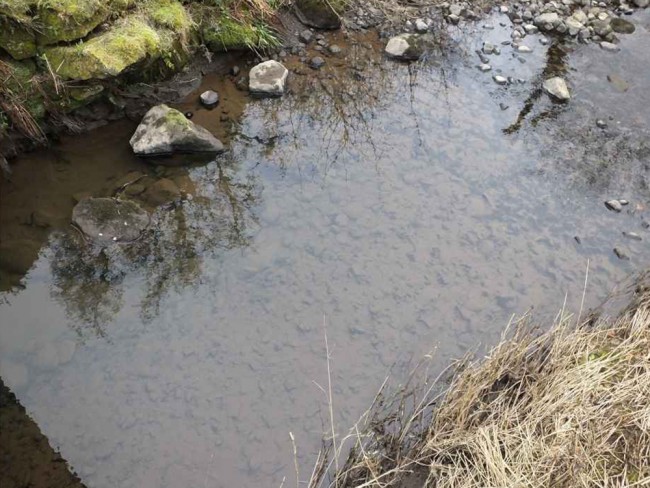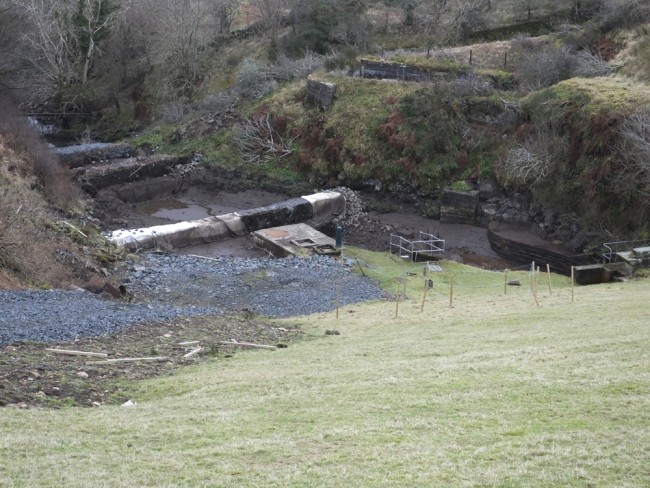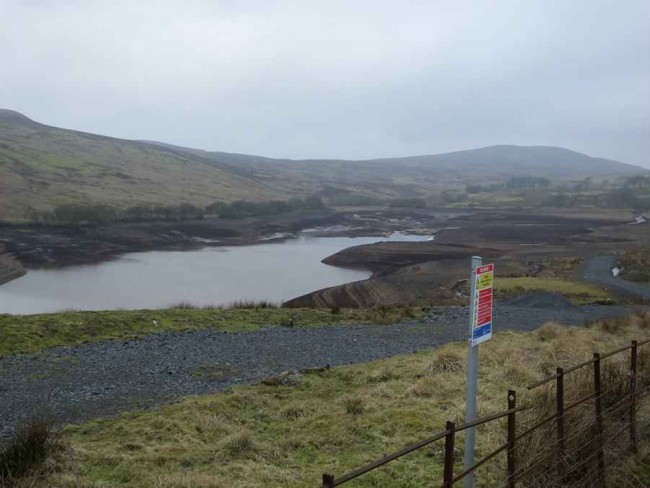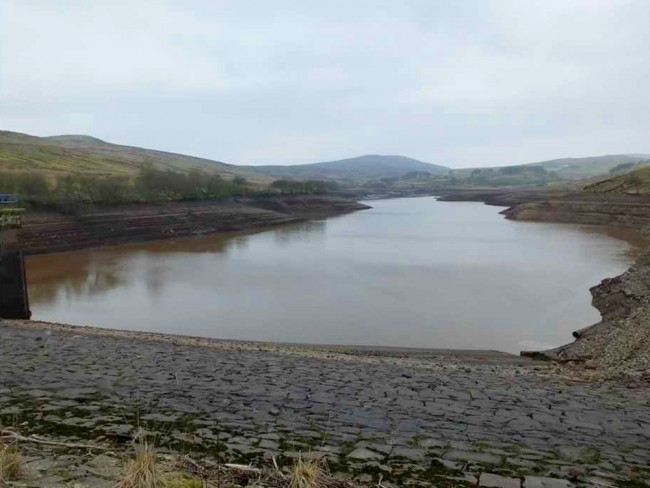We’ve been in consultation with Scottish Water for around 1 year over the planned draw down of Caaf reservoir and breaching of the dam wall. Eventually, the plan is to restore the valley to as near the original profile and habitat as possible with the Caaf Water flowing in the valley floor. That should be a good outcome but first there’s a huge job to drain down and restore the site.
ART were included in the consultation to ensure that the fish were protected in the reservoir and the river downstream. Despite some disagreement over the fish population assessment by consultants and survey requirements for the river downstream of the reservoir, we eventually agreed to undertake a rescue and to move the fish under licence to new locations wherever possible.
Last week we received notification from SEPA that there had been a silt pollution incident from the reservoir as a result of blocked sediment filters. By all accounts the pollution was fine sediments that hadn’t settled out and had ultimately ended up at sea with little impact on the fish population. A meeting arranged for this morning allowed me to see what progress had been made and to have a look at the Caaf Water for myself. Almost 1 week after the pollution incident and I found plenty of evidence of heavy silting on what was a clean river bed last summer.

SEPA described the silt as having limited impact on fish populations as most sediment had been carried in ‘Solution’ to the sea. I suspect they meant suspension but I did find evidence that substantial quantities of silt had dropped out en route.

The view of the settlement ponds where the membrane filters chocked with fine sediment. Consequently the ponds overflowed allowing silt to head downstream. Improvements are about to be made so this shouldn’t happen again.
How the level of impact on the Caaf Water’s trout and salmon populations can be assessed is a mystery as despite concerns raised by ART, no monitoring was required in advance of the works. We do have data from 2013 from the lower river but nothing from above the Linn where Jacob’s ecologist assessed the trout population as poor. ART disputed the evidence for this assumption.
The reservoir has been drained to a low level prior to the pollution after which SEPA required improved sediment management and control. Draw down has been suspended for the time being. ART now have to rescue the remaining fish from the reservoir several months before we had recommended due to the advanced stage of the draw down. Whilst not ideal, hopefully we will be able to catch as many trout and eels as possible before the draining recommences. This isn’t going to be an easy task especially in February when water temperatures are low and the fish may be lying close to the bottom.

The Caaf Reservoir at much reduced levels. Within a couple of weeks we will be afloat and netting what fish we can from this water.
Once Scottish Water has improved sediment management, the levels will be reduced and the reservoir emptied. I suspect we will have several days of netting to ensure most fish are removed. I hear that we should expect few rainbows, many tiny brownies and a good number of eels. Despite a few problems to start with, I hope that the outcome will be a good one.



I hope the fish will be put into other dalry waters
William, we are trying to find a suitable receiving water for the fish. Of course it is impossible to predict just how many fish may be available following the rescue but I expect many small brown trout, eels and possibly a few rainbows to feature. We will be relocating fish under licence from Marine Scotland and therefore any waters willing to take stocks should immediately contact the Trust to discuss the options and allow us to put the necessary paperwork in place. Put simply, we can only relocate to waters included on the licence which I’ll be applying for in the very near future. Dalry Angling Club has decided not to take the fish for their other still waters for various reasons. Other clubs nearby are being (or have been) approached.
That looks terrible.
A curse on Scottish Water and their contractors.
Stuart, does the Caaf Water still receive compensation flow from the Camphill system ?
As per ART pages “•Many water supply reservoirs constructed in the hills on the west side of the catchment. Caaf Water receives a compensation flow of 3.4Mlitres/day from the Camphill Reservoir.”
Given that the Rye Water is the major spawning burn on that side of the catchment…have they thought about releasing the compensation directly back into the Rye rather than diverting it to the Caaf burn ?
Whatever the rights or wrongs of this decommissioning, ART’s sole involvement will be to rescue as many fish as possible and secure the best possible outcome for them. Time is against us and despite recommendations that this doesn’t take place until April/May we now find ourselves having to move quickly as the levels have already been reduced.
Regarding the compensation flow to the loch from Camphill Reservoir, we contacted Scottish Water querying this. Apparently there is no compensation flow from Camphill and currently the only inputs are from Knockendon and several wee burns surrounding the reservoir. Scottish Water will confirm this to me next week once they have investigated further. It wouldn’t be in their interest to be diverting water to the Caaf while attempting to drain it so I suspect they have already considered their options. It does no harm to see confirmation on this though.
I realise that it wouldn’t be in their commercial interest to do so (I think they also deny abstracting directly from the main flow of the Garnock above Kilbirnie even though the infrastructure is still in place, and has definitely worked recently, and there is completely trustworthy anecdotal evidence that this is the case)…the question in this context is why the ART website who we as laymen rely on for scientifically correct information has just accepted what Scottish Water says about compensation flows and re-published erroneous information ?
….and take a wee break while Stuart runs away to delete offending paragraph…
Also, whilst I appreciate that you’ve tried to answer the question from Mr. Beveridge in general terms and without going into detail I’d be pleased if you could e-mail me (you have the address) to tell me who represented DGAC and unilaterally decided that the wee Caaf broon troot shouldn’t be relocated to further down the Caaf below the falls, or to the main stream of the Garnock, or indeed to the Thirdpart reservoir ?
Regards,
Davy.
Davy, I won’t be deleting anything until I have clarification of the situation. I asked the question of Scottish Water based on our understanding of the situation and the concerns you raised. The response I posted was what I received and as I stated before, we still await confirmation of the actual situation. Our site is based on the information we received and believe to be correct. If it turns out that this is incorrect, we will obviously update the page. The Trust strives to ensure that that information we post is factual and correct. We don’t have resources nor the ability to ‘investigate’, abstraction and compensation data provided to us and reproduced in good faith. As it has been questioned we have in turned asked for clarity and until I receive an answer, we won’t be changing anything on our site.
Regarding the abstraction on the Garnock above Kilbirnie, yes the infrastructure is in place as in an abstraction licence agreement with the regulator but I understood (from discussions with SEPA) that it has been some time since it was used. I will seek clarity on the matter next week. I should point out that there is currently a developer attempting to secure agreements to abstract from this area for Hydro purposes and will keep readers posted should it develop further (hence our surveys of the upper catchment reported on these pages last year).
I will message you with details as requested regarding the relocation of the fish.
Hi Stuart,
Thanks for swift reply…I’ll get back to you in relation to matters in your e-mail once I’ve had a chance to discuss with other parties….
I was actually just pulling your leg about deleting info on the website, though !